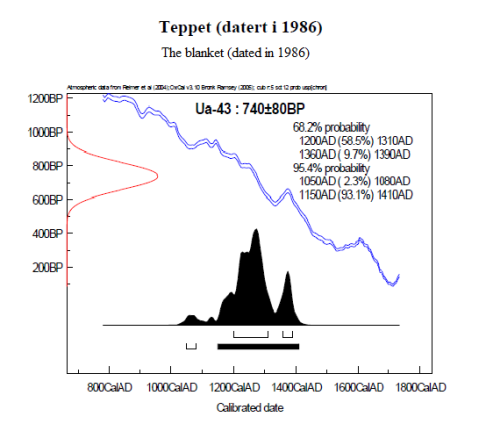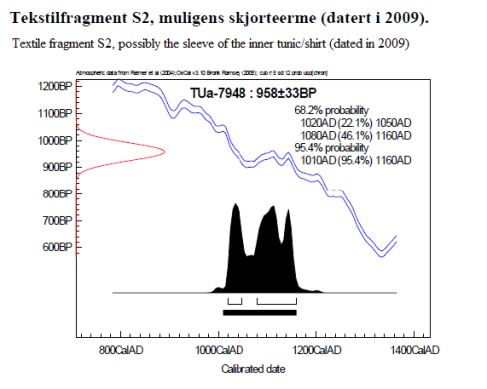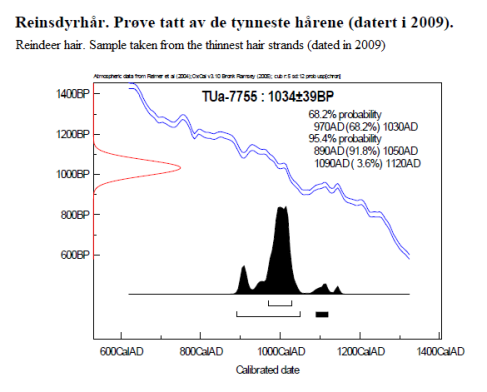This will be my first serious blog post in ages. It’s going to be about something that I’ve thought about for a long time. There has been much debate over the Skjoldehamn find and its ethnicity, is it ”viking” or is it ”Saami”? But not so many people has cared to critically discuss its dating. I think it’s about time to do just that.
So, first things first. What evidence do we have?
The Skjoldehamn outfit is a complete outfit found in Andøya, very far north in Norway, in 1936. It was found in a bog by a man cutting peat. The police ordered it to be reburied in a graveyard, but it was instead reburied just next to the original place where it was found. This was in June, and by autumn the museum in Tromsø had heard about the find, but it was assumed to be no more than 200 years old, so they did not want to carry out any archaeological excavations straight away, instead urging a farmer to dig it up and send it to the museum. Here it was taken care of by archaeologist Guttorm Gjessing, who analysed it and published an article about the outfit. He concluded that it was a late 15th, perhaps early 16th century, outfit, based on the appearance of the kirtles. On of them had a collar that Gjessing meant dated it to the late middle ages. It had similarites to later Saami outfits, but Gjessing meant that the person wearing it was culturally Norwegian, based on some elements in the cutting and the use of the sewn socks, something that the Saami people never wore according to Gjessing. The similarities were explained by Saami outfits being influenced by medieval Norwegian outfits. The strange burial site, in an unholy bog instead of sacred ground, was explained as punishment for evil deeds.
The individual itself is a slender person found in a bog, wrapped in chequered blanket, on a reindeer skin and some rods of birch, and a layer of birch bark covering it. The bone material reveals nothing about the gender of the person, just that it has been quite short, around 160 centimeters tall. DNA analysis showed no traces of Y-chromosomes and not any saami specific DNA sequences. The conclusion was that the person was a Norwegian woman. I must say that this conclusion is a bit rash, since DNA can degenerate over a thousand years and genetic ethnicity is not necessarily the same as cultural ethnicity. I don’t believe the possibility of the person being a Saami man, Saami woman or Nordic woman can really be ruled out. A Nordic man is less likely, given that the corpse is below the Nordic male average even in that time period, but it can’t be ruled out either.
What era is that then? Gjessings estimate was based on his knowledge about costume history. With the advent of radiocarbon dating we have been given yet another tool to work with in dating this kind of archaeological remains. So what did the 14C dating show?
The first datings, done in 1986 and 87, concerns the blanket and the bone material. These dating showed a calibrated date of 1180-1280 AD for the blanket, and 1000-1210 AD for the bone material. The graphs looked like this:
These datings were ”normalised” in a book by Margareta Nockert and Göran Possnert, called ”Att datera textilier” (Dating textiles), published in 2002. A calibrated date of 936-1023 is set for the blanket. That is the last dating for the blanket.
In connection with his master thesis, Nye tanker om Skjoldehamnfunnet (New Thoughts on the Skjoldehamn find), Dan Halvard Løvlid, in 2009 additional datings were done. The samples were taken from the outer tunic (called ”kofta” in Norwegian), the textile fragment S2 (referred to as ”probably a piece of the sleeve of the inner tunic (”skjorte”, literally ”shirt” and ”skjorteerme”, ”shirt sleeve”) as well as some of the reindeer hairs that were found in the grave. The datings were as such:
This is where it gets exciting. Løvlid arrives at one conclusion. Below is the original in Norwegian, and my translation:
”Dateringene av teppet (Ua- 11037) og reinsdyrfellen (TUa- 7755) peker mot siste halvdel av 900-tallet og første halvdel av 1000-tallet. Koftas datering (TUa- 7754) peker mot siste halvdel av 1100-tallet og tidlig 1200- tall, men også mot siste halvdel av 1000- tallet. Fragment S2 (TUa- 7948) peker mot sent 1000- tall til litt over første halvdel av 1100- tallet. Tendensen er derfor at teppet og reinsdyrfellen virker eldre enn kofta og fragmentet. Dette kan også tenkes å være riktig. Mens klær gjerne er en forbruksvare som fort blir slitt, kan tepper og skinnfeller holde seg lengre ved moderat bruk. Det kan derfor hende at den gravlagte har fått med seg et gammelt teppe og en gammel reinsdyrfell i graven. Spørsmålet blir i så fall hvor gamle disse kan ha vært ved nedleggelse, og dette er det nesten umulig å svare på. […] Jeg tror uansett at dateringene av teppet og reinsdyrfellen gjør at vi trygt kan se bor ifra koftas tyngdepunkt på 1150-1210 e. Kr. Da står vi igjen med toppunktet på 1050-1090 e. Kr. ”
”The dating of the blanket (Ua-11037) and the reindeer hide (Tua-7755) indicates second half of the 10th century and the first half of the 11th century. The dating of the outer tunic (Tua-7754) indicates the late 12th century and early 13th century, but also the second half of the 11th century. The fragment S2 (Tua-7948) indicates late 11th century to a little after the middle of the 12th century. Because of that the tendency is that the blanket and the reindeer hide appears to be older than the tunic and the fragment. This could very well be. While clothing is a commodity that is quickly worn out, blankets and reindeer hides can last much longer than that with moderate use. It might be that the buried person has had an old blanket and an old reindeer hide along with the person itself in the grave. The question is how old these were when they were put in the grave, but this is almost impossible to say. […] I believe that the dating of the blanket and the reindeer hide makes it safe to disregard the emphasis of the tunic to 1150 – 1210 AD. We are then left with the indication of 1050 – 1090 AD.”
This is where we can begin to discuss the results. I don’t believe this at all. I think, in short, what Løvlid arrives at is somewhat remarkable. First he concludes that we are probably dealing with a younger outfit buried with an older blanket and reindeer hide. Then he chooses to completely change his previous statement and arrives at the conclusion that it is more or less the same age as the blanket and the hide. Also I think that the view that the whole costume was made at the same time, along with the other items in the grave, is very unlikely. Until further radiocarbon dating, preferably from other items of clothing in the grave, as well as the many pieces of fabric used to repair the outfit, which could give us an interesting hint about how long the garments were in use before they ended up in the grave, my conclusion is that the Skjoldehamn outfit should most likely be dated to the medieval period and not to the viking age.
Sources:
Nye tanker om Skjoldehamnfunnet, Dan Halvard Løvlid, Master thesis from the University of Bergen, 2009
See forth the sources Løvlid states for his thesis.





